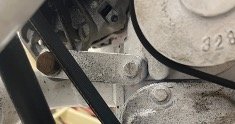There seems to be a difference between a automotive and a marine application for belts.
This is what ChatGPT came up with.
The specific V-angle for serpentine belts typically varies by application, but in general:
- Automotive Serpentine Belts: Commonly have a groove angle of 36° to 40°.
- Marine Serpentine Belts: Often use a slightly different angle, usually in the range of 38° to 42° or more, to accommodate the unique demands of marine environments.
The slightly wider angle in marine belts helps improve water expulsion and maintain grip under wet conditions, which is critical for consistent performance in a marine setting. However, the exact angle can vary between manufacturers and specific belt designs.
Key Differences in Pulleys:
- Material and Corrosion Resistance
- Marine Pulleys: Made from corrosion-resistant materials like stainless steel, aluminum, or specially coated metals to withstand saltwater and humidity. This prevents rust and ensures longevity in the harsh marine environment.
- Automotive Pulleys: Typically made from standard steel or cast iron with anti-corrosion coatings, but not specifically designed for heavy saltwater exposure. Over time, exposure to moisture and salt can cause these pulleys to corrode.
- Pulley Design and Groove Angle
- Marine Pulleys: Often designed with deeper or slightly different groove angles to match the unique profile of marine serpentine belts, which improves water shedding and grip. They may also have wider or more aggressive grooves to handle high RPMs and the potential for water contact.
- Automotive Pulleys: Designed to match the standard automotive serpentine belt angle and depth. They generally lack additional water-shedding features since automotive engines are enclosed and protected from direct water exposure.
- Load and Durability
- Marine Pulleys: Built to handle higher continuous loads and the demands of long, sustained high RPMs, which are typical in marine engines.
- Automotive Pulleys: Optimized for variable RPMs, stop-and-go conditions, and lighter loads compared to marine engines.
So while both types of pulleys serve similar functions, the marine versions are built tougher with a focus on durability and corrosion resistance to meet the needs of the marine environment.
The 6bt Cummins was originally a automotive application and I assume a the drive pulley is for an automotive belt and the Balmar pulley might be for a marine belt. Just a thought. It would be interesting to hear what Balmar thinks about this.

